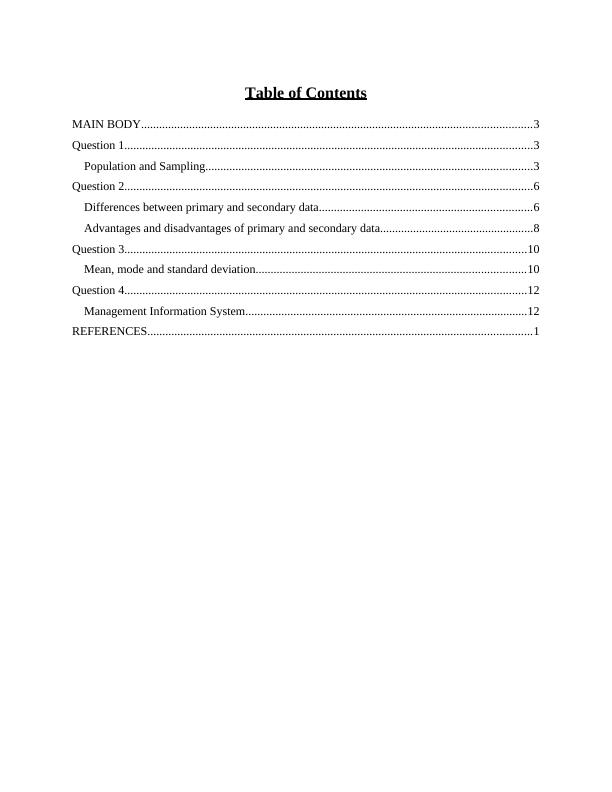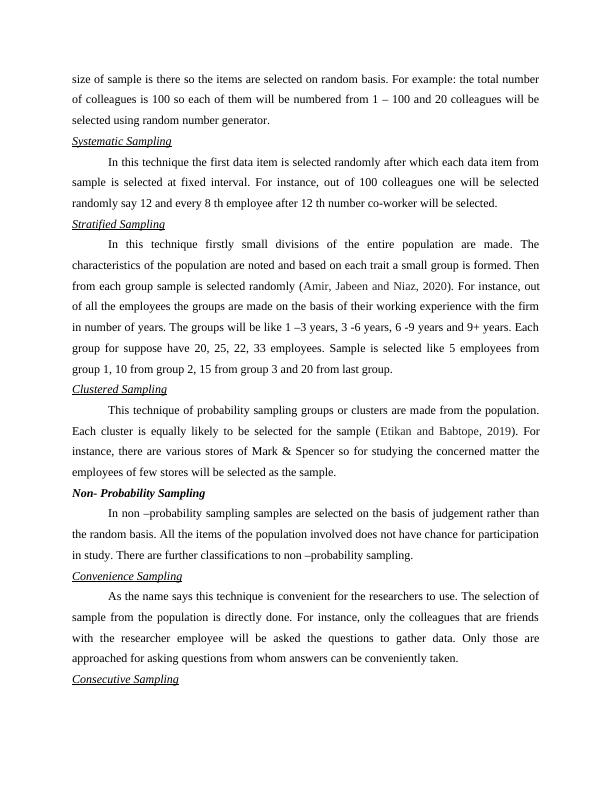Business Analysis: Population and Sampling, Primary and Secondary Data
Added on 2023-06-08
15 Pages4871 Words447 Views
Business Analysis

Table of Contents
MAIN BODY..................................................................................................................................3
Question 1........................................................................................................................................3
Population and Sampling.............................................................................................................3
Question 2........................................................................................................................................6
Differences between primary and secondary data.......................................................................6
Advantages and disadvantages of primary and secondary data...................................................8
Question 3......................................................................................................................................10
Mean, mode and standard deviation..........................................................................................10
Question 4......................................................................................................................................12
Management Information System..............................................................................................12
REFERENCES................................................................................................................................1
MAIN BODY..................................................................................................................................3
Question 1........................................................................................................................................3
Population and Sampling.............................................................................................................3
Question 2........................................................................................................................................6
Differences between primary and secondary data.......................................................................6
Advantages and disadvantages of primary and secondary data...................................................8
Question 3......................................................................................................................................10
Mean, mode and standard deviation..........................................................................................10
Question 4......................................................................................................................................12
Management Information System..............................................................................................12
REFERENCES................................................................................................................................1

MAIN BODY
Question 1
Population and Sampling
Population
It is used to refer to the complete set of objects involving which conclusions will be
formed for conducting a statistical study (Berndt, 2020). The pool of data for a study is called
population. The data in which one is interested for their studies is known as population. The
given scenario of survey of employees over the possibility to extent the working day and
working hours by Marks & Spencer company will have the total number of employees working
within the organization at all levels as the population of the survey.
Population is of high significance whenever a survey is being conducted. It is important
in order to understand the population that is to be targeted for the survey. Populations states the
data that will be referred to during the entire study. If the clarity regarding the population of
study is absent then the researcher will end up in collecting wrong data and the entire study will
fail in meeting its objectives. Hence it is of great significance.
Sampling Techniques
Sampling techniques refers to the process that will be followed during the research for
studying the target set out of the population. Study is done by information collection and analysis
of collected data. Sampling techniques are broadly classified into two probability sampling and
non- probability sampling.
Probability sampling
In probability sampling items are selected on random basis. There exists chance for each
eligible data item to be selected from the population. The probability sampling methods
consumes more time and high cost is incurred as compared to non- probability sampling
(Oribhabor and Anyanwu, 2019). The main advantage of this is that there is surety that the
selected sample will effectively represent the entire population. There are further more
bifurcations to this types of sampling technique, these are:
Simple Random Sampling
In this type of sampling every item exist in
the population is equally likely to selected in sample. The other name given to this technique is
method of chance selection. In simple random or representative sampling techniques the large
Question 1
Population and Sampling
Population
It is used to refer to the complete set of objects involving which conclusions will be
formed for conducting a statistical study (Berndt, 2020). The pool of data for a study is called
population. The data in which one is interested for their studies is known as population. The
given scenario of survey of employees over the possibility to extent the working day and
working hours by Marks & Spencer company will have the total number of employees working
within the organization at all levels as the population of the survey.
Population is of high significance whenever a survey is being conducted. It is important
in order to understand the population that is to be targeted for the survey. Populations states the
data that will be referred to during the entire study. If the clarity regarding the population of
study is absent then the researcher will end up in collecting wrong data and the entire study will
fail in meeting its objectives. Hence it is of great significance.
Sampling Techniques
Sampling techniques refers to the process that will be followed during the research for
studying the target set out of the population. Study is done by information collection and analysis
of collected data. Sampling techniques are broadly classified into two probability sampling and
non- probability sampling.
Probability sampling
In probability sampling items are selected on random basis. There exists chance for each
eligible data item to be selected from the population. The probability sampling methods
consumes more time and high cost is incurred as compared to non- probability sampling
(Oribhabor and Anyanwu, 2019). The main advantage of this is that there is surety that the
selected sample will effectively represent the entire population. There are further more
bifurcations to this types of sampling technique, these are:
Simple Random Sampling
In this type of sampling every item exist in
the population is equally likely to selected in sample. The other name given to this technique is
method of chance selection. In simple random or representative sampling techniques the large

size of sample is there so the items are selected on random basis. For example: the total number
of colleagues is 100 so each of them will be numbered from 1 – 100 and 20 colleagues will be
selected using random number generator.
Systematic Sampling
In this technique the first data item is selected randomly after which each data item from
sample is selected at fixed interval. For instance, out of 100 colleagues one will be selected
randomly say 12 and every 8 th employee after 12 th number co-worker will be selected.
Stratified Sampling
In this technique firstly small divisions of the entire population are made. The
characteristics of the population are noted and based on each trait a small group is formed. Then
from each group sample is selected randomly (Amir, Jabeen and Niaz, 2020). For instance, out
of all the employees the groups are made on the basis of their working experience with the firm
in number of years. The groups will be like 1 –3 years, 3 -6 years, 6 -9 years and 9+ years. Each
group for suppose have 20, 25, 22, 33 employees. Sample is selected like 5 employees from
group 1, 10 from group 2, 15 from group 3 and 20 from last group.
Clustered Sampling
This technique of probability sampling groups or clusters are made from the population.
Each cluster is equally likely to be selected for the sample (Etikan and Babtope, 2019). For
instance, there are various stores of Mark & Spencer so for studying the concerned matter the
employees of few stores will be selected as the sample.
Non- Probability Sampling
In non –probability sampling samples are selected on the basis of judgement rather than
the random basis. All the items of the population involved does not have chance for participation
in study. There are further classifications to non –probability sampling.
Convenience Sampling
As the name says this technique is convenient for the researchers to use. The selection of
sample from the population is directly done. For instance, only the colleagues that are friends
with the researcher employee will be asked the questions to gather data. Only those are
approached for asking questions from whom answers can be conveniently taken.
Consecutive Sampling
of colleagues is 100 so each of them will be numbered from 1 – 100 and 20 colleagues will be
selected using random number generator.
Systematic Sampling
In this technique the first data item is selected randomly after which each data item from
sample is selected at fixed interval. For instance, out of 100 colleagues one will be selected
randomly say 12 and every 8 th employee after 12 th number co-worker will be selected.
Stratified Sampling
In this technique firstly small divisions of the entire population are made. The
characteristics of the population are noted and based on each trait a small group is formed. Then
from each group sample is selected randomly (Amir, Jabeen and Niaz, 2020). For instance, out
of all the employees the groups are made on the basis of their working experience with the firm
in number of years. The groups will be like 1 –3 years, 3 -6 years, 6 -9 years and 9+ years. Each
group for suppose have 20, 25, 22, 33 employees. Sample is selected like 5 employees from
group 1, 10 from group 2, 15 from group 3 and 20 from last group.
Clustered Sampling
This technique of probability sampling groups or clusters are made from the population.
Each cluster is equally likely to be selected for the sample (Etikan and Babtope, 2019). For
instance, there are various stores of Mark & Spencer so for studying the concerned matter the
employees of few stores will be selected as the sample.
Non- Probability Sampling
In non –probability sampling samples are selected on the basis of judgement rather than
the random basis. All the items of the population involved does not have chance for participation
in study. There are further classifications to non –probability sampling.
Convenience Sampling
As the name says this technique is convenient for the researchers to use. The selection of
sample from the population is directly done. For instance, only the colleagues that are friends
with the researcher employee will be asked the questions to gather data. Only those are
approached for asking questions from whom answers can be conveniently taken.
Consecutive Sampling

End of preview
Want to access all the pages? Upload your documents or become a member.
Related Documents
Sampling, Hypothesis Testing, and Regressionlg...
|8
|1706
|608
Sampling, Hypothesis Testing, and Regressionlg...
|8
|1706
|278
Sampling: Meaning, Importance, and Methods of Samplinglg...
|2
|547
|57
(PDF) Research Methods in Educationlg...
|11
|2318
|182
Computing Research Methodslg...
|14
|3250
|30
Grounds for Probability and Non-Probability Sampling Case Study 2022lg...
|5
|1042
|22
